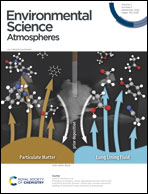Pre-monsoon submicron aerosol composition and source contribution in the Kathmandu Valley, Nepal†
Abstract
The Kathmandu Valley in Nepal suffers from unhealthy air quality, with mean pre-monsoon submicron particulate matter concentration (PM1) of 40 μg m−3 and daily peaks over 75 μg m−3. A high-resolution time-of-flight aerosol mass spectrometer (HR-ToF-AMS) measured ambient non-refractory submicron PM (NR-PM1) in a Kathmandu suburb in April 2015. The mean NR-PM1 composition was 15.8 μg m−3 (39.7%) organic aerosol (OA), 10.5 μg m−3 (25.0%) BC, 8.4 μg m−3 (21.1%) SO42−, 2.96 μg m−3 (7.4%) NH4+, 1.22 μg m−3 (3.1%) NO3−, and 0.92 μg m−3 (2.3%) Cl−. NR-PM1 exhibited a diurnal pattern with concentration maxima at 08:00 local standard time. Afternoon winds and an elevated planetary boundary layer then mitigated NR-PM1. Positive matrix factorization (PMF) of OA mass spectral data identified four primary source components: hydrocarbon-like OA (HOA, 15%), biomass burning OA (BBOA, 15%), trash burning OA (TBOA, 11%), a local sulfur-containing OA (sLOA, 7%), and three oxidized OA (OOA, 50%) factors. sLOA contains the ion C3HSO+, associated with emissions from coal used in brick kilns. Secondary aerosols account for 50% of all OA mass within the valley. Gas-phase carbon monoxide (CO), carbon dioxide (CO2), sulfur dioxide (SO2), nitrogen dioxide (NO2), ozone (O3), methane (CH4), and black and brown carbon (BC, BrC) measurements also characterized pollution in the valley. Composition, concentration, and source analysis from AMS-PMF and filter-based chemical mass balance measurements agree well (OC slope = 1.05, R2 = 0.47). This work identifies and quantifies significant sources of PM1 in the Kathmandu Valley and provides insight into the impact of these sources on overall air quality throughout South Asia.

- This article is part of the themed collection: ES: Atmospheres Hot Papers


 Please wait while we load your content...
Please wait while we load your content...